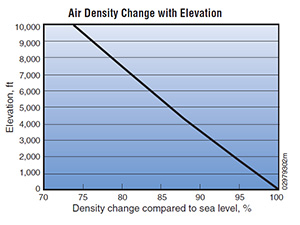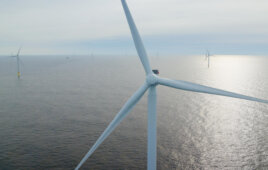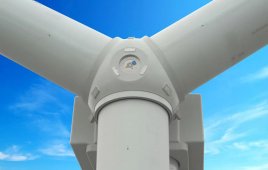Most U.S. manufacturers rate their turbines by the amount of power they can safely produce at a particular wind speed, usually chosen between 24 mph or 10.5 m/s and 36 mph or 16 m/s. The following formula illustrates factors that are important to the performance of a wind turbine. Notice that the wind speed, V, has an exponent of 3 applied to it. This means that even a small increase in wind speed results in a large increase in power. Read How high should your small wind turbine be for more information. That is why a taller tower will increase the productivity of any wind turbine by giving it access to higher wind speeds as shown in the Wind Speeds Increase with Height graph. The formula for how to calculate power is:
![]()
Where:
P = Power output, kilowatts
Cp = Maximum power coefficient, ranging from 0.25 to 0.45, dimension less (theoretical maximum = 0.59)
ρ = Air density, lb/ft3
A = Rotor swept area, ft2 or π D2/4 (D is the rotor diameter in ft, π = 3.1416)
V = Wind speed, mph
k = 0.000133 A constant to yield power in kilowatts. (Multiplying the above kilowatt answer by 1.340 converts it to horse- power [i.e., 1 kW = 1.340 horsepower]).
The rotor swept area, A, is important because the rotor is the part of the turbine that captures the wind energy. So, the larger the rotor, the more energy it can capture.
The air density, ρ, changes slightly with air temperature and with elevation. The ratings for wind turbines are based on standard conditions of 59° F (15° C) at sea level. A density correction should be made for higher elevations as shown in the Air Density Change with Elevation graph. A correction for temperature is typically not needed for predicting the long-term performance of a wind turbine.

Although the calculation of wind power illustrates important features about wind turbines, the best measure of wind turbine performance is annual energy output. The difference between power and energy is that power (kilowatts [kW]) is the rate at which electricity is consumed, while energy (kilowatt-hours [kWh]) is the quantity consumed. An estimate of the annual energy output from your wind turbine, kWh/year, is the best way to determine whether a particular wind turbine and tower will produce enough electricity to meet your needs.
A wind turbine manufacturer can help you estimate the energy production you can expect. They will use a calculation based on the particular wind turbine power curve, the average annual wind speed at your site, the height of the tower that you plan to use, and the frequency distribution of the wind–an estimate of the number of hours that the wind will blow at each speed during an average year. They should also adjust this calculation for the elevation of your site. Contact a wind turbine manufacturer or dealer for assistance with this calculation.
To get a preliminary estimate of the performance of a particular wind turbine, use the formula below.
![]()
Where:
AEO = Annual energy output, kWh/year
D = Rotor diameter, feet
V = Annual average wind speed, mph
The Wind Energy Payback Period Workbook from the National Renewable Energy Labs is a spreadsheet tool that can help you analyze the economics of a small wind electric system and decide whether wind energy will work for you. It asks you to provide information about how you’re going to finance the system, the characteristics of your site, and the properties of the system you’re considering. It then provides you with a simple payback estimation in years. If it takes too long to regain your capital investment—the number of years comes too close or is greater than the life of the system—wind energy will not be practical for you. Read here for more on the physics and economics of wind turbines.
Filed Under: Construction, Projects





Can someone show me a chart of wind turbine output vs wind speed? Also, a chart of wind speed vs time of the day? I am trying to find the real time output of gratiot county wind farm vs time of day and cannot find it. Only max output is listed.
What will be the energy output when speed of wind is 10 miles/hr. ?? :<
Andile ~ tricky question. It depends on the family and their behavior. It depends on the house, is it heated with wood or forced air heating which required a blower frequently. If they’re off grid they should live around the weather. Pump water and do energy intensive things while it’s windy and go into conservation mode when it’s not. Batteries are expensive. I often tell people about their ‘battery bill’ ~ just figure the monthly cost of owning them. I prefer small battery banks and good habits. (so does my back)
Anyone know the steps for this ?
A wind turbine has a blade span of 9m and achieves its rated output of 100kW at 12m/s. If
p=1.225 kg/m3 , calculate the value of the power coefficient Cp.
I don’t agree the Area A in the formula is rotor swept area, it is much exaggerated. The area is even less than blade area. Air flow not pushed on blades will not provide electricity. Industry is larger than its ability.
Long time
I agree that the climate has warmed. However, I disagree that CO2 is the cause. Actually, CO2 is beneficial in cooling the planet as plants utilize CO2 resulting in plants producing Oxygen. At the present time plants are thriving on the planet. Eliminating CO2 completely as some suggest would destroy all life on the earth.
So, what has caused this recent warming? When I was a small child, my father came home from work on a hot day in August and I ran outside barefoot onto the sidewalk to greet him and my feet started burning. I began crying due to the pain so my Dad picked me up and put me on the grass and my feet stopped burning. He went inside and grabbed an egg and put it on the sidewalk and we watched it cook. He then picked me up again and very quickly placed my hand on the car hood and removed it and I felt the intense heat of the car hood. That was my first experience on how manmade materials, that I will call hard pan, when exposed to the sun heats up the environment.
Hard Pan, (i.e., roads, buildings, metals, vehicles etc.) has expanded immensely across the planet in the last one hundred years. This is why in the middle of cities you will find temperatures higher than the city’s outskirts. The current financial system is based on expanding hardpan though the issuance of debt. Developers and corporations borrow money to expand hard pan to payback the loans and to make a profit.
A gold salesman will tell you the financial system is crashing to convince you to buy gold. An electric car salesman will tell you gasoline powered vehicles are warming the planet to convince you to buy electric cars when the electricity that fuels the electric vehicles is primarily generated using fossil fuels. A politician will tell you anything in order to promote a new technology to invest in and make money whether the technology is good or bad for the environment. Most people are not technically savvy and unable to discern though critical thinking the truth, and therefore fall victim to dis/misinformation that is promoted to make a buck. New alternative energy sources such as wind turbines, solar panels and the like, just in a few years become inefficient and require replacement, resulting in more fossil fuels to create them.
In order to mitigate the environmental damage due to hardpan and the expansion thereof, the financial system has to be changed so that expansion of hardpan is stopped and an extensive reduction of existing hardpan is accomplished.
Is there a solution? Yes, there is and it boils down to minimizing the human footprint across the planet through policy. However, you cannot rely on politicians to figure this out when the economy is based on expanding hardpan.
But don’t fear because the earth has a self-correcting mechanism. The melting of glaciers and ice at the north and south poles is reducing the salinity in ocean water and this reduction in salinity of ocean water will slow or stop the gulf stream. This phenomenon will result in a drastic cooling of the planet given time. This may be occurring right now as we are seeing much colder temperatures across the globe last winter and this spring. How is the weather where you are? I am wearing a sweat shirt.
This equation does not take into consideration the upper limit of power output. If we write wind speed = exaggerate value, then we still have a proportional power output, which might be way beyond the maximum power output of our turbine.
Alternatives to this equation? Vestas proposed “S”-shaped curves, for instance.
Thank you
Potential Wind Turbine Power: (m3 = cubic meter)
P = 0.5 x rho x A x Cp x V3 x Ng x Nb
where:
P = power in watts (746 watts = 1 hp) (1,000 watts = 1 kilowatt)
rho = air density (about 1.225 kg/m3 at sea level, less higher up)
A = rotor swept area, exposed to the wind (m2)
Cp = Coefficient of performance (.59 {Betz limit} is the maximum theoretically possible, .35 for a good design)
V = wind speed in meters/sec (20 mph = 9 m/s)
Ng = generator efficiency (50% for car alternator, 80% or possibly more for a permanent magnet generator or grid-connected induction generator)
Nb = gearbox/bearings efficiency (depends, could be as high as 95% if good)
Use half of the potential, as calculated above, for basis in further calculations.
Replace rho with density of water for an interesting result.
@Derek Dutton:
Everyone with more than 2 brain cells understands that CO2 emissions *do* affect climate change. That is why most countries have signed the Paris Climate agreement.
Yes, changes to global temperature have occurred since the ice ages, but nothing compared to what we are seeing the last few decades. There is plenty of solid scientific evidence of human induced climate change and those who are still in denial, have come up with zero facts to backup their point of view,
The fact that some countries recently built coal fired power stations is first of all because these were planned many years ago, and secondly, because we do not have sufficient alternatives yet. Bear in mind that e.g. Germany decided to also stop using nuclear energy, so there is a large gap to fill. Their massive investment in solar power is impressive, but not enough.
Holland is already shutting down those recently built coal fired power plant and is investing heavily in alternative energy sources and reduction of emissions from traffic, industry and agriculture. Even natural gas as a source of energy will be abandoned soon. Wind farms are being built on land and offshore. Same applies to Great Britain.
there is something very wrong with this formula. assuming air density ( which i cant find in this article) of .072lb/ftcubed
.000133 x cp x .5 x d x vcubed
.000133 x .5 x.5 x .072 x 26mph
gives 42 watts. hmm
42 watts from a 3 foot accross wind generator at 26mph. no i dont think so.
at 100 mph
.000133 x .5 x .5 x .072 x 100 cubed
2300 watts sounds a little more feasible. but why do they say the 1 meter ( 3 foot) generators on ebay have a 2000 or 5000 watt rating??
Dear Sir,
I am making a research paper where my subject is very high velocity/ high force air .
If i flow 500 psi pressure by a 5 inch diameter pipe for operating turbine
of generator of 110 volt capacity then how much KW electricity we can obtained
from the generator ?
Is it possible to give me a general idea ?
Waiting for your kind reply.
The best three blade turbines are about 23% efficient according to the Betz limit. The Tension Turbine is about 44-46 % efficient. When the Tension Turbine is adopted, better numbers on costs will occur.
Calculate the energy of wind per unit mass if the power available at the rotor of a wind turbine is 699 kW,
diameter of the rotor, D = 88 m, Air density, ρ = 1.23 kg/m3 and Power Coefficient, Cp = 0.40.
Noe Palacios:
Your calculation is wrong, formula is 0.01328* D^2*V^3. You should have 4 feet squared, and 28mph to the cube:
0.01328*4^2*28^3=4660 KWh/year. Note that 28mph is very hard to achieve, you should use a much more conservative estimate, like 22. Result will be around half, or 2500KWh/year.
There’s something I don’t understand. I calculated the AEO on ideal conditions and it seems to me very small.
AE0=0.01328*4.27*28.09=1.65 kwh/year
The wind generator is rated 1,200 watts
Are the 1.65 kwh/year a adaily average or it’s the whole energy it will produce for the whole year?
I’d like to know the peak voltage and current levels of a peak wind turbine output rated at 24 nominal volts. I’m using a peak voltage of 38v and current of 7a at a 500w maximum output for certain 24v solar panels as a design model for my renewable energy system, powered by both solar cells and windmills. I’ve yet to discover a good ballpark peak voltage and current figure for wind turbines. Can you help?
The turbine will charge the batteries and feed into the Grid. However the “Credit Capacity” amount that wind power can reduce fossil fuel produced megawatt hours is very small and due to wind fluctuations increases instability and needs more fuel. Eon Netz, major German Grid operator says 48,000 MWgs of wind, only replaces 2,000 MWgs of coal power. A Credit Capacity of 4%. Britain is better, having less turbines, around 16%. New York State Power states it gets 10% from a theoretical 30%.
Few people would like to live where Wind Turbine produced its rated power. Needing a Force 7 to 8 gale. Half of which is a 80% drop in output. Despite every effort to smother criticism of the noise. Portugal, Britain and Canadian Health Authorities have found have found ” Vibro-acoustics” producing health problems. Germany. Britain, Holland and Norway are busy building coal fired power stations now it is apparent CO2 has no effect on the climate. Hotter long before oil, coal and industry existed.
pls, i want design a crossflex wind turbine of 1kw for building environment,how can i estimate the generator , the battery sizing, the cp, rotor height speed ratio. note that the wind speed in the area is about 4.6m/s
Thanks for the information posted in your site… I am trying to answer an assignment question and can’t get an answer on it… Question: What determines the amount of electricity circulating in a house for a family using wind turbine, is it the capacity of turbine or the capacity of batteries used in a house? Please help